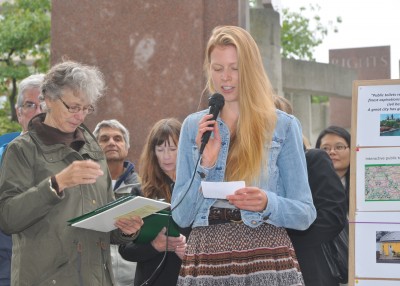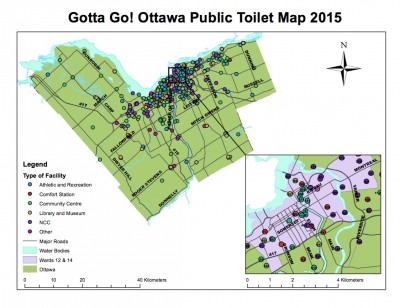By Amy Richardson, CFICE Communications RA
Ottawa is getting a little closer to relief.
“We’ve won some very important victories in terms of toilets at Bayview and Hurdman,” says Joan Kuyek, chair of Ottawa’s GottaGo! Campaign.
GottaGo!, an advocacy group campaigning for a network of public toilets in Ottawa, has lobbied to the city to implement public toilets in the plans of two LRT stations.
The group made its official launch two years ago on November 19th,, coincidentally also World Toilet Day. Ever since, the group has been working hard to create awareness and get support to make accessible public toilets in Ottawa a reality.
With the help of Community First: Impacts of Community Engagement (CFICE), a SSHRC-funded research project aimed at strengthening Canadian communities, GottaGo! brought forward a motion to include public washrooms in phase two of the LRT plan.
CFICE funded two Carleton University undergraduate students to help with the campaign – Rachel Canham and Sarah Good.
Canham, a 2nd year environmental studies and physical geography student at the time, created a report entitled “Talking Toilets: Assessing the accessibility of public toilet provision in Ottawa, Ontario.” The report highlighted how public toilets impact the lives of all Ottawans, especially those most vulnerable. It was presented to council to spur discussion about the lack of Ottawa’s public toilets.
“We were able to use (the report) for our big press conference last September. It really had a lot of impact,” says Kuyek.

Joan Kuyek, left, and Rachel Canham, right, at the GottaGo! press release in September 2014 unveiling Canham’s report. Photo credit: Patricia Ballamingie.
Canham reflects on her experiences with the campaign.
“One of the key issues and questions I asked participants was about the new LRT system not having any public bathrooms. At the time, there were no plans to build any public bathrooms. That got a lot of attention and it ended up being one of the main focuses of my report,” she says.
“It’s a really good thing to incorporate students into the community action. It was really an eye opening experience for me.”
Some of Canham’s interview participants for the report included disabled people, mothers with children, people with irritable bowel syndrome and homeless people.
“I spoke to a number of homeless people and there were a lot of stories that they weren’t able to enter public bathrooms because they were shunned, which draws attention to the fact that there aren’t true public bathrooms that are available to everyone in the City of Ottawa,” she says.
While Canham focused on how future toilets would improve the lives of Ottawa citizens, Good focused on the existing public toilets in Ottawa.
Good, a 4th year geography and geomatics student at the time, mapped all the GPS coordinates for the city’s municipally funded toilets. Her findings showed a gap between public toilets locations in the city.
“I was able to identify some places where there were visible gaps, in particular Centretown especially near MacDonald Park. (This) was one of the areas (GottaGo! was) pushing to get a public washroom installed because there was a lack of any kind of public washroom around there,” Good says.
“I think the mapping helped the campaign because it put a good visual to where the gaps really lie. The map shows where the gaps are and it kind of forces the city to do something with it.”

A map of current public toilets in Ottawa that Sarah Good helped create. Source: GottaGo!
Kuyek says the contribution from the CFICE students was instrumental for their campaign.
“We were able to go to the City Information Technology Committee with (Good’s) information and persuade them we need more toilets,” she says. “Both (Canham and Good) had a huge impact on the campaign in terms of what we were trying to do.”
Bessa Whitmore, member of the core GottaGo! team and professor emerita at Carleton University’s School of Social Work, agrees with Kuyek.
“We really appreciate the support that we’re getting from students from CFICE and other students. This is free work for us, but we wouldn’t be able to do what we’ve done without those students.”
Patricia Ballamingie, academic co-lead of CFICE’s Community Environmental Sustainability Hub, says the benefit went both ways.
“The opportunity for these students to conduct applied research, to help those most vulnerable access public space, anchors academic concepts like the right to the city,” Ballamingie says. “We cannot talk about sustainable community without also considering social justice, and Rachel and Sarah understand this in a meaningful way.”
With Canham’s report, the GottaGo! team presented their motion to implement toilets in the LRT stations to council early July for a vote.
“To our delight and surprise, it was unanimous,” Whitmore says.
Canham was also surprised.
“It’s what the people wanted and there was actual change. It’s really exciting.”
Ottawa city staff working on the LRT phase two plan were instructed to include public toilets in the designs for Bayview and Hurdman stations.
“We’re going to be watching very closely to make sure that they actually follow up,” Whitmore says.
GottaGo! hopes to partner with the city on developing a “where to go” app that would show users the locations of Ottawa’s public toilets, their hours of operation and whether or not they’re accessible.
Kuyek thinks the app will help show the city there aren’t enough toilets.
“We think (the app) will enable us to find out which toilets are actually open and accessible. The city seems to think that when they get the app up, they’ll discover that we won’t need very many toilets because there would be so many,” Kuyek says. “We actually think the opposite is true.”
A group of Master of Social Work students from Carleton University will be conducting a “ground truthing” of the public toilets this winter. They will be looking for accessibility, hours of operation and if the toilet is actually open in the winter. Whitmore expects many of them will only be open during programming hours in the summer and not operational in the winter.
Kuyek plans to gain more support with World Toilet Day events on November 14th. GottaGo! will be having a rain or shine gathering from 12-2pm at Dundonald Park in Centretown. The public is welcome to attend for an afternoon of entertainment and dancing.